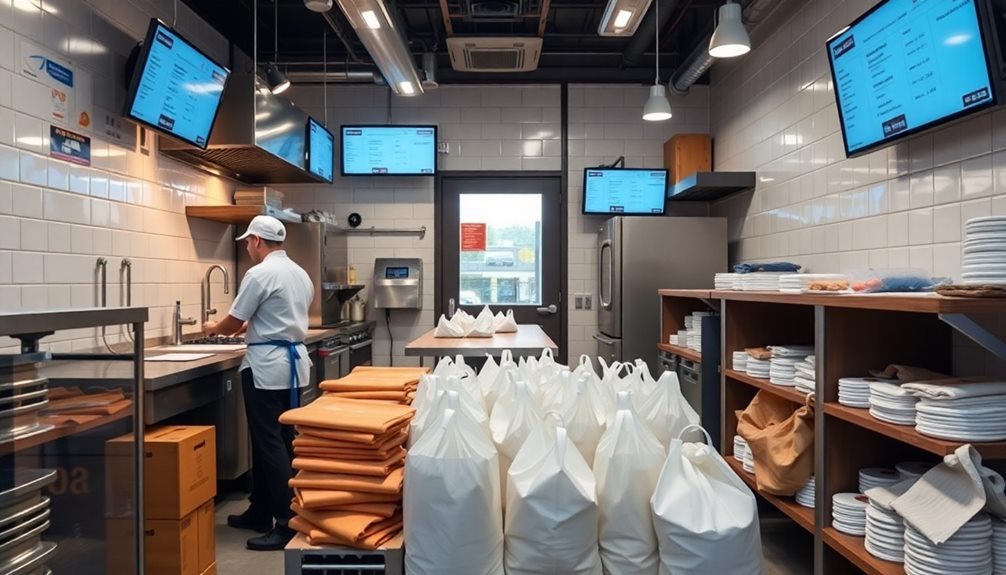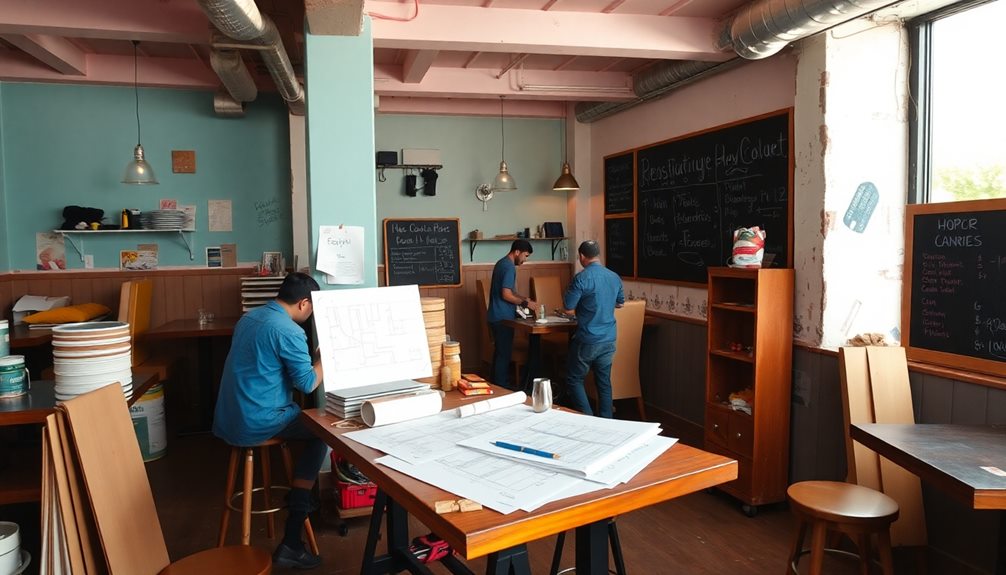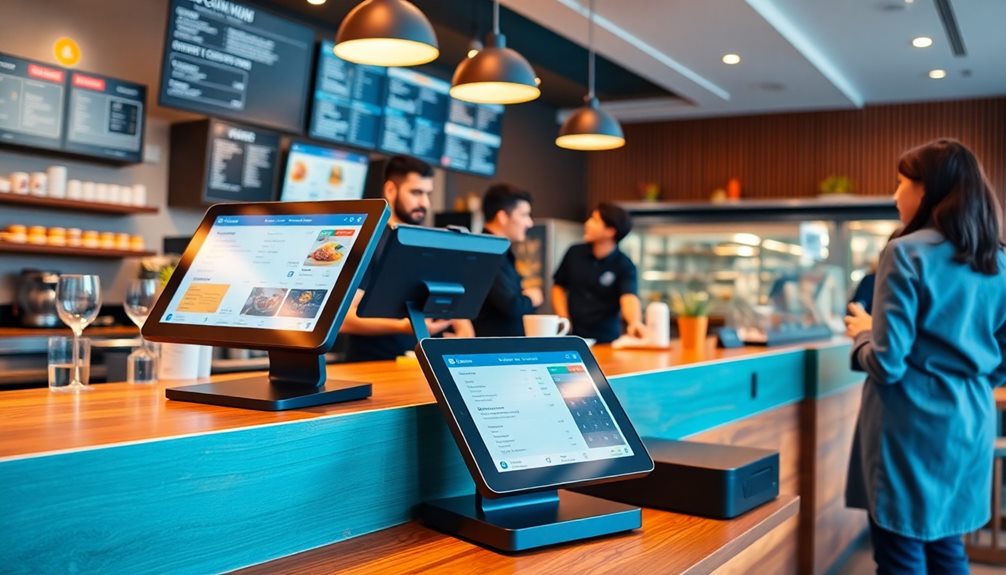A ghost kitchen is a food preparation facility solely for delivery and takeout, skipping the traditional restaurant space. You benefit from lower startup costs, as these kitchens share resources and can operate multiple brands under one roof. Deliveries usually happen through third-party apps like UberEats or DoorDash, streamlining orders and logistics. This model lets you quickly adapt menus to customer preferences and market trends. While there's high competition, the potential for diverse offerings and higher profit margins makes ghost kitchens appealing. Curious about how their operational strategies work? There's much more to discover about this growing trend.
Key Takeaways
- Ghost kitchens operate exclusively for food delivery and takeout, eliminating the need for a traditional storefront.
- They share kitchen space and resources, reducing startup costs by 50-60% compared to conventional restaurants.
- These kitchens utilize third-party delivery apps for logistics and employ technology for efficient order management.
- Multiple brands can operate from a single kitchen, allowing for diverse menu options and rapid experimentation.
- The model aligns with consumer preferences for delivery, as approximately 60% of U.S. consumers favor food delivery or pickup options.
Definition of Ghost Kitchens

When you think about modern food delivery, ghost kitchens play an essential role in that landscape. Also known as cloud kitchens or dark kitchens, these innovative commercial cooking spaces operate exclusively for food delivery without the traditional dine-in experience.
They're designed to meet the growing demand for takeout and delivery, especially since the COVID-19 pandemic spurred a significant shift in consumer behavior.
Ghost kitchens leverage existing restaurant infrastructure or shared kitchen facilities to prepare meals for various virtual brands, which are primarily marketed through online platforms. This approach allows businesses to tap into the booming food delivery market while minimizing costs.
With lower overhead costs compared to traditional restaurants, ghost kitchens eliminate the need for front-of-house staff and physical storefronts.
This model fosters rapid experimentation with menu items and enables a single kitchen to serve multiple brands, enhancing operational efficiency and expanding market reach. Additionally, by streamlining food preparation and optimizing ingredient usage, businesses can significantly reduce waste and operational costs. This approach has proven particularly effective in competitive dining destinations like the best restaurants in Koh Samui, where culinary variety and innovation are key to attracting diverse clientele. As a result, kitchens can cater to different preferences while maintaining consistent quality across multiple brands.
Essentially, ghost kitchens are redefining how food is prepared and delivered, providing a flexible solution for entrepreneurs aiming to capitalize on the growing appetite for delivery options.
How Ghost Kitchens Operate

Ghost kitchens operate by leveraging commercial kitchen spaces specifically designed for efficiency in food delivery. These kitchens focus solely on fulfilling online orders and don't have physical storefronts, which allows them to streamline operations.
Here's how they typically work:
- Shared Facilities: Many ghost kitchens share kitchen spaces with existing restaurants or operate in dedicated commissary kitchens, lowering overhead costs.
- Third-Party Delivery Apps: They rely on platforms like UberEats and DoorDash to handle delivery logistics, making it easier for you to order from multiple virtual brands.
- Order Management Technology: Restaurant owners utilize a single device to manage online orders across various brands, ensuring smooth operation.
- Dedicated Staff: Trained personnel handle delivery orders, which enhances cooking efficiency and boosts order accuracy, leading to higher customer satisfaction.
With the ability to quickly adapt menus and launch new concepts based on consumer demand, ghost kitchens provide a flexible model that benefits both restaurant owners and customers.
This approach not only meets the rising demand for convenient delivery options but also optimizes operational strategies in the food industry.
Appeal of Ghost Kitchens

The surge in food delivery demand, especially during the Covid-19 pandemic, has made ghost kitchens increasingly appealing to both consumers and restaurant owners. With about 60% of U.S. consumers now favoring food delivery or pickup options, the ghost kitchen concept aligns perfectly with the trend toward convenience. For existing restaurants, this model allows them to diversify their revenue streams without the significant overhead costs associated with traditional restaurants.
Here's a quick comparison to illustrate the appeal:
| Feature | Ghost Kitchens | Traditional Restaurants |
|---|---|---|
| Startup Costs | Lower due to no dining space | Higher due to real estate costs |
| Operational Costs | Reduced overhead | Higher maintenance and staff |
| Delivery Focus | Primarily delivery services | Dine-in and delivery services |
The rise of the gig economy has also contributed to the growth of the delivery market, offering cheaper food delivery services. As more people opt for takeout, ghost kitchens present a financially attractive solution for restaurants looking to adapt swiftly to changing consumer behaviors.
Advantages of Ghost Kitchens

Ghost kitchens offer you significant advantages that can reshape your dining experience.
With low overhead costs, you can enjoy higher profit margins while benefiting from quick adaptability to market trends.
Plus, the ability to run multiple brands from a single kitchen means you get a diverse menu without the usual constraints of traditional dining spaces.
Low Overhead Expenses
In today's competitive food industry, a restaurant's overhead expenses can make or break its success. Ghost kitchens offer a unique solution by considerably lowering these costs compared to traditional restaurants. Without the need for dine-in space or front-of-house staff, you can focus on what matters—delivering quality food efficiently.
Here are four ways ghost kitchens help you save money:
- Reduced Start-Up Costs: Start-up expenses can be 50-60% lower than conventional restaurants, with median construction costs around $200,000.
- Shared Kitchen Facilities: Utilizing shared or rented commercial kitchens minimizes costs related to equipment purchase and maintenance.
- Affordable Locations: The absence of a physical storefront allows you to operate in less expensive areas, decreasing rent costs considerably.
- Higher Profit Margins: Streamlined operations for online delivery can lead to profit margins increasing by approximately 30% compared to traditional models.
Quick Market Adaptability
Operating with lower overhead costs not only boosts profitability but also enhances market agility. Ghost kitchens excel at quickly adapting their menus based on real-time consumer demand, allowing you to test new concepts without the limitations of a traditional restaurant.
This flexibility means you can pivot your business strategies rapidly, enabling the launch of multiple virtual restaurants from a single location to capture diverse market segments.
Utilizing shared kitchen spaces considerably reduces the time and financial investment needed to establish a new food concept, facilitating faster entry into the market. You can leverage technology for order management and fulfillment, which streamlines operations and enhances operational efficiency.
This is essential in a competitive delivery environment, guaranteeing high customer satisfaction.
Moreover, ghost kitchens allow you to respond swiftly to shifts in consumer preferences, like the increasing demand for delivery orders and takeout options. By remaining attuned to these trends, you can guarantee your offerings stay relevant in a dynamic market.
With ghost kitchens, you not only save costs but also gain the agility to thrive amidst changing consumer landscapes.
Multiple Brand Opportunities
Accessing multiple brand opportunities is one of the standout advantages of ghost kitchens. This innovative model allows you to operate multiple virtual restaurant brands from a single existing kitchen, greatly reducing overhead costs.
Here's how you can benefit:
- Diverse Menu Offerings: Launch various virtual brands, catering to different tastes and preferences without needing separate physical locations.
- Lower Investment: Utilize your existing kitchen space and staff to create additional revenue streams with minimal additional investment.
- Rapid Innovation: Quickly adapt to customer demand by testing new menu items, ensuring you stay ahead in the competitive restaurant industry.
- Scalability: Major players like MrBeast Burger have shown how ghost kitchens can rapidly expand to nearly 1,000 locations, highlighting the scalability of multiple virtual restaurant brands.
As the ghost kitchen market is projected to reach $1 trillion by 2030, tapping into these opportunities can enhance your food delivery business, driving profitability and growth.
Embracing this model not only maximizes your kitchen's potential but also positions you competitively in the evolving culinary landscape.
Disadvantages of Ghost Kitchens

While ghost kitchens offer convenience, they come with significant drawbacks.
You might struggle with building brand loyalty since the delivery-only model limits personal interaction with customers.
Additionally, ensuring consistent food quality can be tough when delivery processes are out of your direct control.
Brand Loyalty Challenges
Brand loyalty faces significant challenges in the world of ghost kitchens. The delivery-only model limits your ability to connect with customers, making it hard for them to develop a strong emotional attachment to virtual brands.
Here are some key factors affecting brand loyalty in this arena:
- Lack of Direct Interaction: Without personal connections with staff, customers miss out on the dining experience that fosters loyalty.
- High Competition: Numerous ghost kitchen brands vie for attention on delivery platforms, complicating the effort to stand out and build a loyal customer base.
- Easy Brand Switching: The convenience of trying new options leads to customers frequently experimenting with different ghost kitchens rather than returning to one.
- Third-Party Delivery Services: Customers may remember the delivery app more than the ghost kitchen itself, diluting brand identity and hindering long-term loyalty.
These elements create a challenging landscape for ghost kitchens, where building lasting customer relationships can seem like an uphill battle.
As a result, many brands struggle to establish the loyalty that's essential for sustained success in the competitive food delivery market.
Quality Control Issues
Quality control issues often crop up in ghost kitchens, primarily due to the lack of direct customer interaction. Without immediate feedback, it becomes tough for you to make necessary adjustments during service, leading to inconsistency in food quality.
When you rely on third-party delivery services, you risk receiving dishes that arrive at the wrong temperature or presentation, ultimately diminishing the overall dining experience.
Moreover, the high competition among numerous virtual brands can dilute your brand identity, making it challenging to uphold consistent quality standards across different offerings. This can confuse customers, as they mightn't know what to expect from your restaurant business.
The absence of a physical dining space limits opportunities for staff training and quality assurance, which directly impacts food preparation and customer service.
In this environment, customer loyalty may suffer since delivery-only models make it hard to build a personal connection with your clientele. Establishing a strong relationship is essential for maintaining quality and a solid brand reputation.
As a result, these quality control issues can greatly hinder your success in the ghost kitchen landscape.
Setting Up a Ghost Kitchen

Setting up a ghost kitchen requires careful planning and understanding of the market landscape. To successfully launch your ghost kitchen, focus on these key components:
- Define Your Concept: Create a clear restaurant concept that emphasizes a delivery-friendly menu. Choose items that maintain their quality during transport and appeal to your target consumers.
- Identify Kitchen Space: Look for suitable kitchen space, whether it's shared or rented facilities. Confirm that your chosen location complies with local health and safety regulations, and consider utilizing existing restaurant infrastructures.
- Confirm Compliance: It's vital to comply with necessary insurance and safety standards. This will help you operate legally and protect your business from potential liabilities.
- Develop a Marketing Plan: A robust marketing plan is essential. Prioritize a strong digital presence by leveraging social media, SEO, and partnerships with major delivery apps to enhance visibility and attract customers.
Types of Ghost Kitchens

When exploring types of ghost kitchens, you'll find commissary kitchens and incubator kitchens stand out.
Commissary kitchens offer shared spaces that help multiple food businesses thrive without the hefty overhead costs.
On the other hand, incubator kitchens provide new concepts a chance to test their ideas in a supportive environment linked to established restaurants.
Commissary Kitchens Overview
Commissary kitchens serve as an essential resource for food entrepreneurs, offering shared kitchen spaces that are both cost-effective and compliant with health regulations.
These facilities are ideal for food businesses, especially food trucks and small startups, allowing them to focus on food preparation without the burden of high overhead costs.
Here are some key features of commissary kitchens:
- Cost Efficiency: By sharing resources, you can greatly reduce your operational expenses.
- Compliance: These kitchens meet health and safety regulations, so you don't have to worry about individual licensing.
- Fully Equipped: Most commissary kitchens come with essential kitchen equipment, storage, and prep space, making it easier to manage your operations.
- Flexibility: You can test new food concepts and adapt your offerings quickly to meet the growing demand for delivery and takeout services.
Utilizing a commissary kitchen allows you to optimize resource usage and maximize efficiency.
This collaborative environment fosters innovation, enabling you to bring your culinary ideas to life while maneuvering through the complexities of the food industry.
Incubator Kitchen Benefits
Incubator kitchens offer a unique advantage for food entrepreneurs looking to test new concepts without the commitment of a full-service restaurant. These temporary kitchen spaces are often linked to existing restaurants or food trucks, providing you with a cost-effective solution to explore your culinary ideas.
By utilizing shared resources, you can save money while ensuring compliance with health regulations.
As a type of ghost kitchen, incubator kitchens allow you to experiment with a flexible menu. You can adjust your offerings based on immediate consumer feedback, enabling you to quickly pivot to meet market demand. This responsiveness is essential for success in today's fast-paced food industry.
Additionally, incubator kitchens foster a collaborative environment where you can share insights and resources with fellow chefs. This collaboration often leads to innovation and creativity in menu development, enriching your culinary repertoire.
Strategically located in urban areas, incubator kitchens maximize your exposure to potential customers, increasing the likelihood of successful brand launches.
Market Trends and Insights

Transforming the food delivery landscape, ghost kitchens are emerging as a powerful trend in the restaurant industry.
With the market projected to reach $1 trillion by 2030, the demand for online food delivery has skyrocketed, especially post-pandemic. You're likely part of the 60% of U.S. consumers ordering delivery or pickup weekly, reflecting a shift in consumer behavior.
Here are some key market trends and insights about ghost kitchens:
- Rapid Growth: Meal delivery services saw a 162% sales increase in April 2020 compared to the previous year, showcasing the shift towards convenience.
- Urban Expansion: Major restaurant brands, like MrBeast Burger, are rapidly expanding ghost kitchens, opening nearly 1,000 locations to meet demand.
- Diverse Operators: Both established companies and independent operators are entering the ghost kitchen space, taking advantage of changing consumer preferences.
- Tech-Driven Efficiency: Virtual kitchens are leveraging technology to streamline operations, enhancing revenue potential while minimizing overhead costs.
These trends highlight how ghost kitchens are reshaping the restaurant landscape, making them a crucial component of the future of food delivery.
Marketing Strategies for Ghost Kitchens

As ghost kitchens continue to reshape the restaurant landscape, effective marketing strategies become essential for standing out in a competitive environment. Developing a strong online presence is key, especially since 60% of U.S. consumers order delivery or pickup weekly.
Leveraging merchant account credit processing can facilitate smoother transactions, enhancing customer satisfaction and boosting visibility. Utilize digital marketing campaigns to boost visibility and enhance customer engagement.
Utilizing social media platforms and optimizing your content for search engines can notably improve brand awareness. Ghost kitchens often rely on these channels to attract customers in a crowded marketplace.
Additionally, create a digital-first menu that highlights delivery-friendly items; high-quality visuals and clear descriptions enhance the online ordering experience.
Form partnerships with major delivery platforms like UberEats and DoorDash. These collaborations not only increase your exposure but can also lead to favorable terms that enhance profitability.
Continuously monitor your marketing performance to adjust strategies based on customer feedback and emerging trends. This proactive approach guarantees that your ghost kitchen remains competitive in the evolving food delivery landscape while maximizing customer satisfaction and loyalty.
Future of Ghost Kitchens

The future of ghost kitchens looks promising, with the market projected to reach a staggering $1 trillion by 2030. This growth is driven by increasing consumer demand for delivery and takeout services, reshaping the food service landscape.
As you explore this evolving sector, consider these key trends:
- Rise of Culinary Experimentation: Ghost kitchens allow chefs to experiment with diverse menus without the overhead of traditional restaurants.
- Celebrity-Branded Concepts: Partnerships with well-known chefs and influencers will become more common, drawing in fans and expanding reach.
- Adaptable Business Models: As delivery app regulations change, ghost kitchens will need to adapt their operational strategies to maintain efficiency and profitability.
- Focus on Convenience: With consumers increasingly prioritizing convenience, ghost kitchens will cater to this demand, offering quick, quality meals that fit busy lifestyles.
Frequently Asked Questions
What Is the Point of a Ghost Kitchen?
You're looking at a ghost kitchen to streamline operations and cut costs. By focusing entirely on delivery, you can cater to growing consumer demand, maximize kitchen resources, and quickly adapt your menu based on preferences.
How Do You Tell if a Place Is a Ghost Kitchen?
You can tell if a place is a ghost kitchen by checking online-only menus, delivery app exclusivity, and lack of a physical storefront. If you can't dine in, it's likely a ghost kitchen.
What Is an Example of a Ghost Kitchen?
Picture a bustling burger business, MrBeast Burger. It creatively combines celebrity charm and convenience, delivering delicious dishes without a dine-in setup. You can enjoy tasty meals from popular names right at your doorstep.
What Are the Disadvantages of Ghost Kitchens?
You'll face challenges with ghost kitchens, like high competition, reliance on costly delivery platforms, and difficulty in building loyalty. Quality control can suffer too, affecting customer satisfaction and repeat business, ultimately impacting your profits.
Conclusion
To sum it up, ghost kitchens are reshaping the food industry by cutting overhead costs and boosting efficiency. As you ride this wave of innovation, you'll see how they cater to the ever-growing demand for delivery and takeout. While they come with their own set of challenges, the benefits often outweigh the drawbacks. So, whether you're a budding entrepreneur or a food lover, keeping your finger on the pulse of this trend will serve you well.









